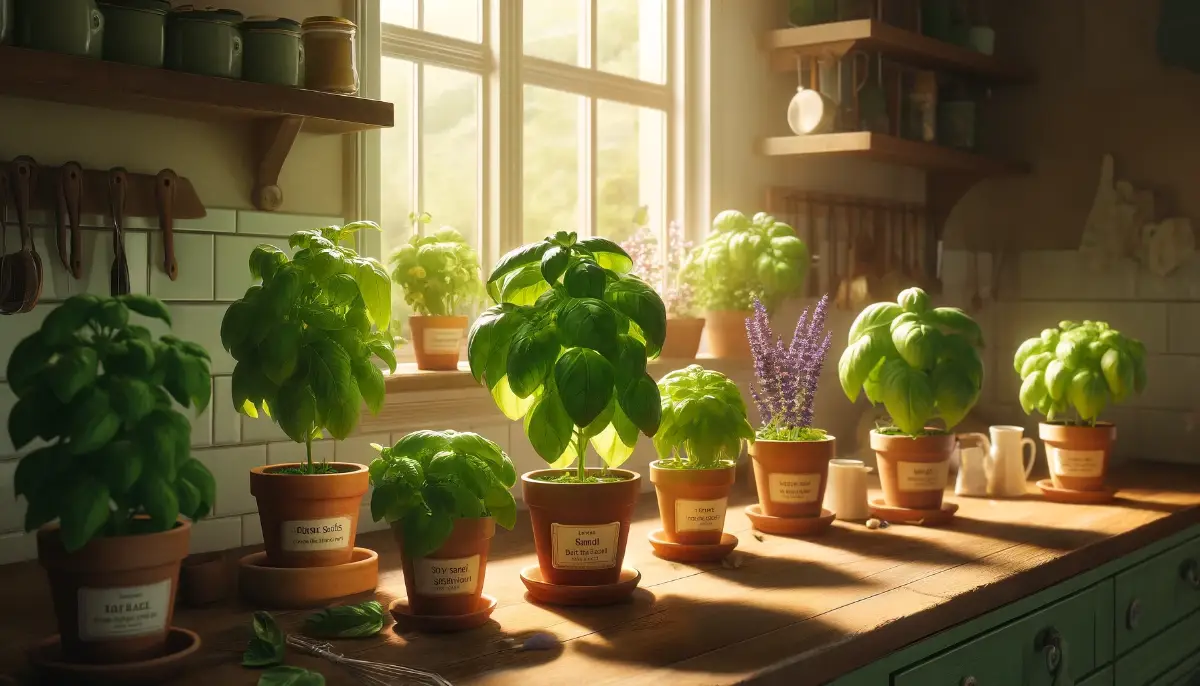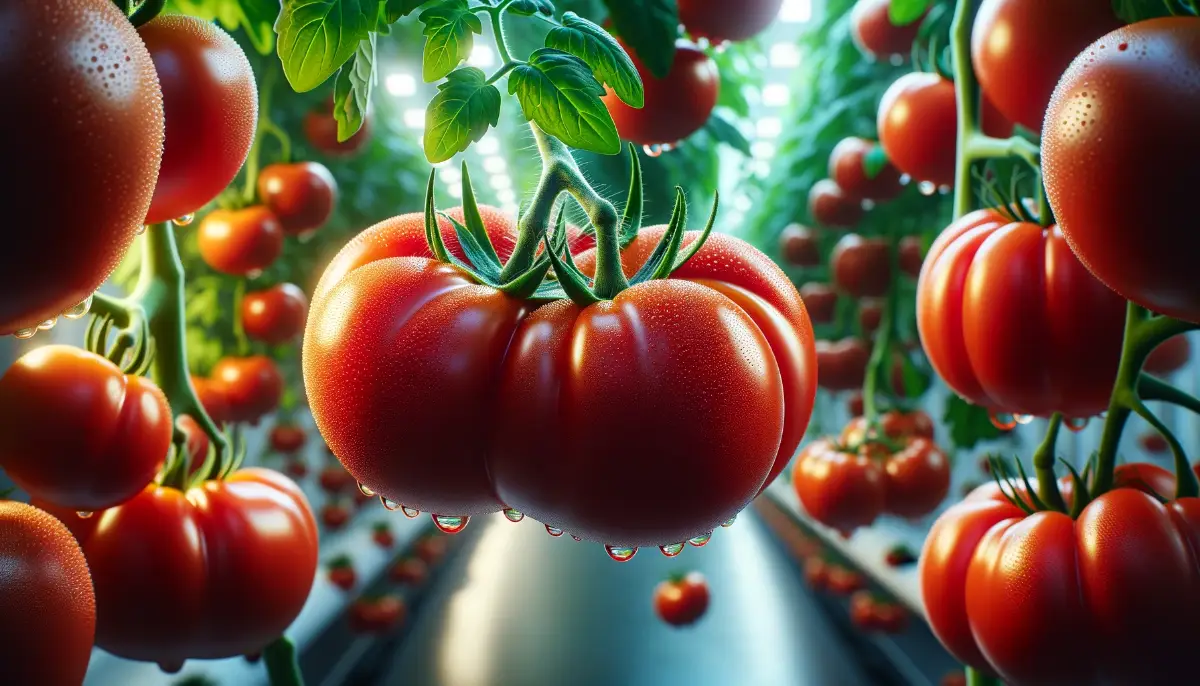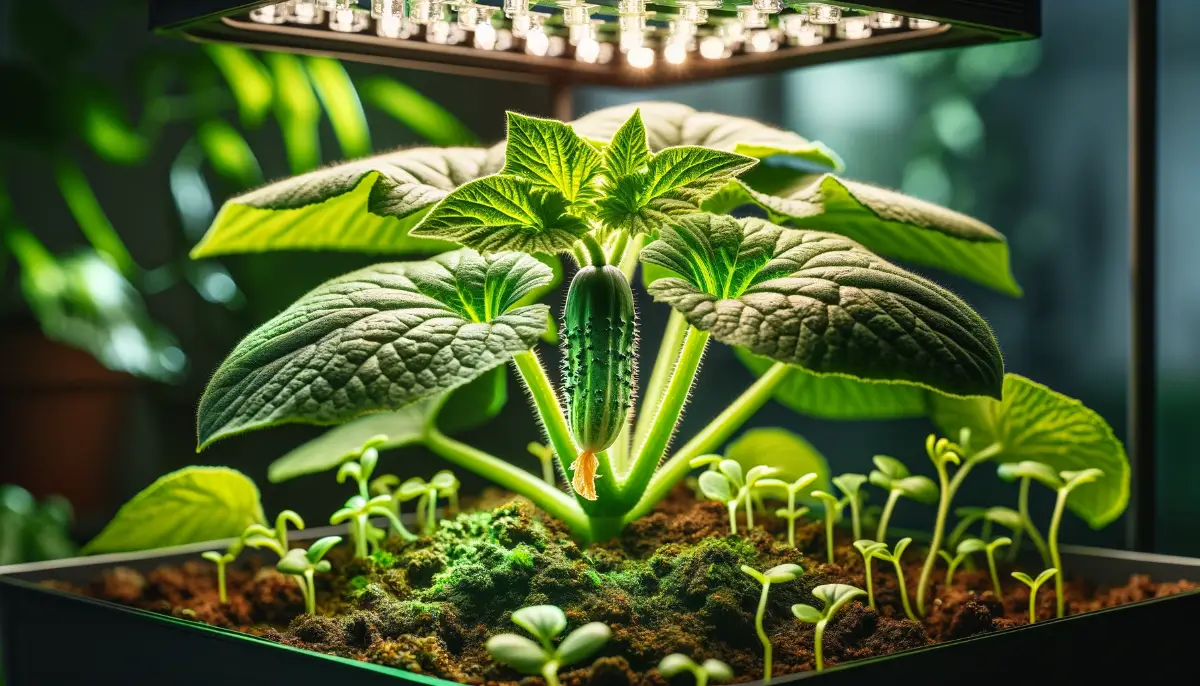Growing basil indoors is not only a delightful way to have fresh herbs at your fingertips, but it’s also a simple pleasure that brightens any home.
As an essential herb in cuisines around the globe, basil (Ocimum basilicum) is cherished for its aromatic leaves that can transform the simplest dish into a masterpiece.
How to Grow Basil Indoor and Its Varieties
Basil is a versatile herb belonging to the mint family, with over 60 different varieties, each offering unique flavors and aromas.
From the sweet Italian Genovese, perfect for pesto, to the spicy Thai basil used in Asian cuisine, there’s a variety for every palate and recipe. Growing basil indoors allows you to experiment with these varieties, providing a constant supply of fresh herbs that can elevate your home cooking to new heights.
Selecting Your Basil Variety
Choosing the right variety is crucial when growing basil indoors. Each variety offers unique flavors and growth habits:
- Lemon Basil: Known for its crinkled bright green leaves and compact growth, making it an excellent choice for indoor cultivation.
- Cinnamon Basil: Offers a spicy, fragrant aroma and flavor, adding a unique twist to dishes.
- Greek Basil: Small leaves with good flavor, ideal for adding whole to salads and sauces.
- Holy Basil: Used in Thai cooking, it adds a distinct flavor to stir-fries.
- Purple Basil: Adds visual interest with its reddish-purple leaves, often used in Asian cuisine.
Consider varieties like ‘Genovese’, ‘Mrs Burns Lemon’, and ‘Purple Ruffles’, noted for their RHS Award of Garden Merit, indicating reliable performance in indoor conditions.
Essential Supplies for Growing Basil Indoors
To kickstart your indoor basil garden, you’ll need a few basic supplies:
- Seeds or Seedlings: Begin with high-quality basil seeds or seedlings of your chosen variety.
- Potting Mix: Opt for a nutrient-dense, well-draining potting mix to promote healthy root growth.
- Containers: Select containers with drainage holes to prevent waterlogging. A 4-inch pot is ideal for individual plants, but larger containers can accommodate more plants if spaced properly.
- Light: Basil requires abundant light. South-facing windows are ideal, but if natural light is limited, supplement with LED or fluorescent grow lights placed 6-12 inches above the plants
Benefits of Growing Basil Indoors
One of the most compelling reasons to grow basil indoors is its array of health benefits. Basil is high in antioxidants, vitamins A and K, and minerals like iron and calcium, making it a nutritious addition to your diet.
Furthermore, having basil readily available encourages the use of fresh herbs over dried, ensuring your meals are packed with flavor and nutrients.
In addition to its health benefits, indoor basil gardening offers the convenience of year-round cultivation, regardless of the weather outside. This is particularly advantageous for those living in colder climates, where outdoor gardening is limited to specific seasons.
Indoor basil plants can thrive on a sunny windowsill, bringing a touch of greenery to your home and making fresh basil leaves available whenever you need them.
Optimal Growing Conditions
Basil’s love for warmth and light is paramount in its indoor cultivation. The herb flourishes in temperatures hovering between 65-70 degrees Fahrenheit, embodying the essence of its tropical heritage. Its need for sunlight is equally vital, with a preference for 6-8 hours of direct exposure daily.
For those facing challenges in providing natural light, grow lights serve as a splendid alternative, illuminating your basil’s world for 12 hours to mimic the sun’s embrace.
Soil and Planting
The foundation of any plant’s health lies in its soil, and basil is no exception. A light, well-draining, compost-based potting soil not only nurtures but also protects your basil from common adversaries like root rot.
When potting, choosing the right container is crucial—a pot with drainage holes and enough room for the basil to grow prevents waterlogging and promotes healthy root development.
Watering and Humidity
Basil’s thirst for water is matched by its preference for a humid environment, echoing its tropical origins. The soil should remain consistently moist but not waterlogged, a balance achieved by attentive watering and the use of pebble trays to elevate humidity levels around the plant.
This meticulous attention to moisture replicates the natural conditions basil craves, fostering a lush, vibrant growth.
Fertilizing and Pruning
Feeding your basil with organic fertilizers enriches the soil with nutrients essential for growth, enhancing the flavor and health of your herb. Regular pruning not only encourages a bushier growth but also prolongs the plant’s productivity, ensuring a steady supply of fresh basil leaves for your culinary endeavors.
Growing basil indoors generally reduces the risk of pest and disease issues compared to outdoor cultivation. However, vigilance is key to preventing and managing any problems that do arise. Here are strategies to keep your indoor basil healthy and thriving.
Preventing Pests
The key to pest management is prevention. Maintain a clean growing environment and inspect your plants regularly for any signs of pests. Common pests for indoor basil include aphids, spider mites, and whiteflies. Here are some preventive measures:
- Isolation: When introducing new plants to your indoor garden, quarantine them first to prevent the spread of potential pests.
- Hygiene: Regularly remove any dead leaves or debris from your plant containers to avoid attracting pests.
- Air Circulation: Ensure good air circulation around your plants, but avoid strong drafts. A gentle fan can help prevent pests and diseases by reducing humidity around the plant foliage.
Managing Pest Infestations
If pests are detected on your basil plants, early intervention is crucial. Here are some effective methods for managing infestations:
- Manual Removal: For minor infestations, you can often remove pests by hand or with a gentle water spray.
- Insecticidal Soap: Safe for use on edible plants, insecticidal soaps can effectively control aphids, spider mites, and other soft-bodied pests without harming your basil.
- Neem Oil: An organic option that acts as both a pest deterrent and a fungicide, neem oil can be applied to basil plants to control pests and prevent fungal diseases.
Disease Prevention
Diseases in indoor basil are often related to overwatering or poor air circulation, leading to fungal issues like root rot or powdery mildew. To prevent diseases:
- Water Wisely: Water your basil plants at the soil level to avoid wetting the leaves, and ensure the soil is well-draining to prevent waterlogging.
- Proper Spacing: Space your plants adequately to ensure good air circulation, reducing the humidity around the leaves and preventing fungal spores from taking hold.
- Clean Tools: Always use clean shears or scissors when pruning or harvesting basil to prevent the spread of any diseases.
Implementing these pest management and disease prevention strategies will help ensure your indoor basil plants remain healthy and productive. By staying vigilant and responding quickly to any signs of trouble, you can enjoy lush, flavorful basil leaves for your culinary creations.
Harvesting and Storing
The final joy of growing basil indoors lies in the harvest. Cutting the leaves in the morning, when their essential oils are most concentrated, captures the essence of basil’s flavor.
For long-term storage, drying or freezing the leaves preserves their aromatic qualities, ensuring that you have access to the taste of summer, even in the depths of winter.
Growing basil indoors is a rewarding endeavor that enhances your cooking and contributes to a healthy diet. With the right care, you can enjoy the lush, fragrant leaves of your basil plants throughout the year, adding a fresh touch to your culinary creations.
Whether you’re a seasoned gardener or new to the world of indoor herbs, basil is a fantastic place to start your green-thumb journey.
FAQs: Growing and Caring for Basil indoors
What type of pot is best for growing basil indoors?
Discover the ideal pot materials and sizes for thriving indoor basil plants.
How much light does indoor basil need to grow successfully?
Uncover the optimal lighting conditions to ensure your basil grows lush and full.
What is the best soil mixture for indoor basil plants?
Learn about the soil composition that will give your indoor basil the nutrients it needs.
How often should I water my indoor basil plant?
Get insights into the watering schedule that keeps basil hydrated without overwatering.
Can I use artificial light to grow basil indoors, and if so, what type?
Explore how artificial lighting can supplement sunlight for your basil and which types are most effective.
What are common pests that affect indoor basil plants and how can I prevent them?
Identify common pests that target basil and preventative measures to protect your plants.
How can I encourage my basil plant to grow bushier and produce more leaves?
Learn trimming and care tips to stimulate growth and increase your basil yield.
Is it necessary to fertilize indoor basil plants? If so, what should I use?
Understand the role of fertilization in basil care and the best types of fertilizers to use.
Can I grow basil indoors year-round, and how can I do it?
Find out how to maintain a continuous supply of basil indoors, regardless of the season.
How do I harvest basil leaves without harming the plant?
Master the technique of harvesting basil so your plant remains healthy and productive.









